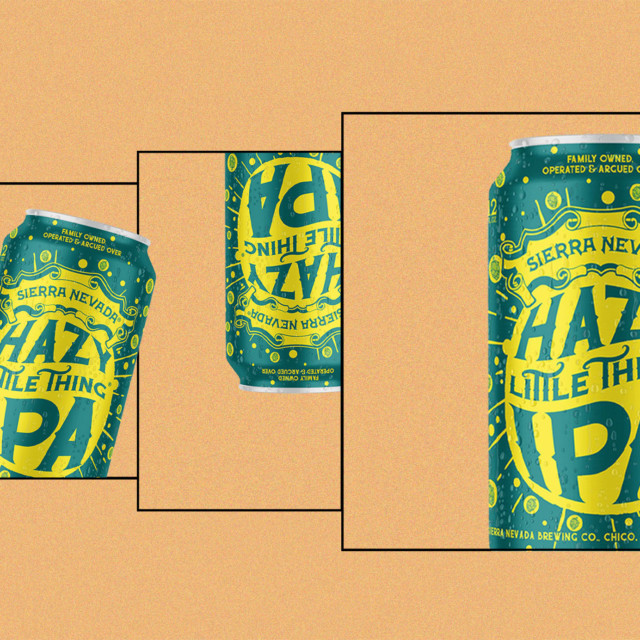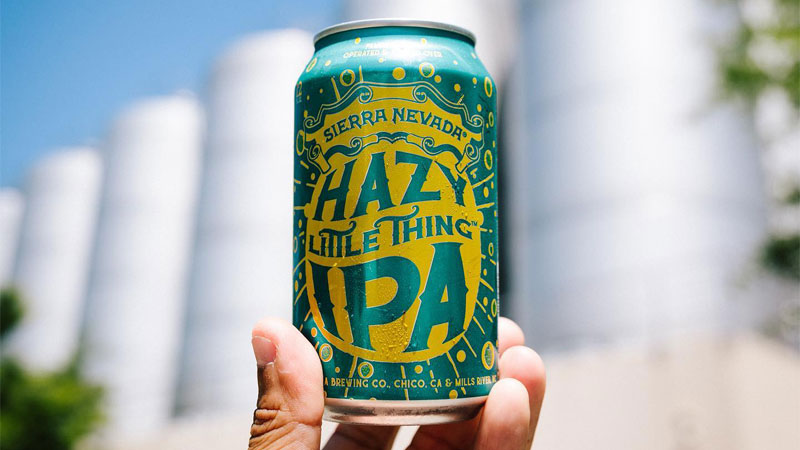The first major project at a new job is always daunting. But Sean Lavery, the individual tasked with developing the extremely successful Sierra Nevada Hazy Little Thing IPA, is deserving of more than a hearty pour of appreciation in this respect.
Lavery joined Sierra Nevada in 2017 as vice president of technical innovation and brewing. Steve Dressler, the man whose boots he was essentially filling, had been in charge of Sierra Nevada’s brewing program since the early ‘80s, and had overseen the development of almost every new beer for 30 years. Not only was Lavery replacing this legendary craft brewing figure, but the first beer he was tasked to work on wasn’t exactly par for the course for his new home.
“I’d been talking with a lot of people in the industry and told them we were working on a hazy IPA,” Lavery says. “They gave me a lot of sh*t for it. They were like, ‘Don’t tell me Sierra Nevada is going down the path of chasing trends.’”
The trend in question: New England IPA (NEIPA), or what’s come to be known more commonly as hazy IPA. By the mid- 2010s, craft beer geeks had taken to queuing outside breweries to snag cans of these ultra-hopped, unicorn beers on release days — namely because they remained hyper-local, and fell off a cliff, quality-wise, within a fortnight. When Sierra Nevada turned its hand to the style, the brewery was therefore shooting for the unheard of: stabilizing the hazy IPA, and ultimately taking it across the country.
The brewery achieved that goal with the launch of Hazy Little Thing in January 2018. Every year since its introduction, Hazy Little Thing has exceeded the brewery’s expectations. It is now Sierra Nevada’s best-selling draft product, and even outperforms its iconic Pale Ale, which launched in 1980. By next year, the brewery expects Hazy Little Thing to overtake Sierra Nevada Pale Ale as its most successful brand across the board. Yet Hazy Little Thing’s current status belies an unconventional backstory, especially where large-scale breweries are concerned.
Hazy Little Legacy
Launching a hazy IPA doesn’t seem particularly earth-shattering in today’s landscape, where nearly every brewery in the country offers at least one interpretation of the style. So it’s worth reiterating just how big a deal this was at the time.
“Sierra Nevada pioneered the really piney, bitter quintessential West Coast-style pale ale,” says Gerard Leary, a beer industry professional who’s run craft beer bars in New York since 2011, and most recently opened Sweet Avenue, a bar-bottle-shop hybrid in Sunnyside, Queens. “But then, over time, you see these hazy guys come out — the newer kids on the block — and they’re taking over that ‘craft’ mantle, while Sierra’s become this huge company.”
He’s referring to Brooklyn’s Other Half, Finback, and Grimm — indie beer pop stars with commensurate brethren in the aforementioned New England (notably: The Alchemist in Vermont and Trillium in Massachusetts.)
In other words, Sierra Nevada launching a hazy IPA was like the Rolling Stones getting down with the kids and turning to disco at the end of the ‘70s. In 2018, the burning question was: Would Lavery be able to come up with his own “Miss You?”
Hazy Little Recipe
If he was going to achieve success with (the still-unnamed) Hazy Little Thing, Lavery knew he had to get it right the first time. The Sierra Nevada sales team wanted theirs to be the first nationally distributed hazy IPA, but Samuel Adams and New Belgium were also cooking up similar projects at the time. (Sierra Nevada would ultimately beat Sam Adams by three months, while New Belgium’s hazy launched at a very similar time, though not nationally.)
“It was pretty nerve-wracking making this beer,” Lavery says. “I was thinking: ‘We’ve got to make sure that it’s good. It’s gotta deliver on flavor. And it has to be hazy.’”
Unfortunately, the initial runs did not tick the most important box: They weren’t hazy. And Lavery soon learned there was no one-size-fits-all solution. The proprietary Chico Ale yeast strain he was brewing with — the same used for Sierra Nevada Pale Ale — ended up being notoriously tricky for this style. The beer’s base contained a complex blend of malted and unmalted oats and wheat, whose proteins would provide the all-important creamy mouthfeel and cloudy appearance (together, essentially, haze). And Sierra Nevada’s notorious “hop torpedo” invention, incredibly useful for adding hop flavor sans bitterness, also proved extremely efficient at stripping haze.
“Long story short, we made it work,” Lavery says. “I’d say, probably three months in, we had the recipe nailed.”
There was little time to rest, however, and quite literally for Lavery. During the early days of Hazy Little Thing’s release, he’d stay up late almost every night, flipping through Untappd on his phone, looking at reviews and wondering, “Is it still hazy out there?”
Meanwhile, the sales team implemented strategy for a small-volume, draft-only brand. Best case scenario, explains Joe Whitney, Sierra Nevada’s chief commercial officer, it would follow the typical beer growth model: built in the on-premise for a year or so before demand slowly seeped over into package retail stores.
Hazy Little Thing was anything but typical.
“Chain retailers were really excited about this beer and we had a lot of authorizations from around the country right away,” Whitney says. “[Then] we got into an out-of-stock situation really quickly because it just took off.”
Hazy Little Thing’s splashy packaging is another case of Sierra Nevada landing on its feet somewhat accidentally: An internal designer was tasked with creating some graphics for the newly minted brand, and came back with finalized designs within two days. Including naming the beer, “The branding was probably a three- or four-day exercise,” says Whitney.
The instant success brought further complications on the production side: 100,000 barrels of Hazy Little Thing crossed the brewery’s threshold that first year, but it had only forecasted for 20,000. “We didn’t have the hops for that,” Lavery says. “We were watching this train coming at us, and we were like, ‘Holy crap, we’re going to run out of hops in July. What are we going to do?’”
Lavery and his team experimented with hop varieties and schedules, adding different hops at different times during fermentation to achieve the tropical character they desired. To this day, recipe tweaks and developments remain a constant in Hazy Little Thing’s production, in order to maintain this character with varying ingredients while also ensuring a perfect haze.
This careful balancing act extends beyond hop projections and ingredient ratios. A large part of what’s enabled Sierra Nevada to take its hazy IPA coast to coast is having breweries in both places: one in Chico, Calif., and the other in Mills River, N.C., opened in 2015. To ensure that the beers are completely consistent, the brewing teams need to use exactly the same hops — from the same lots — for each batch.
The process, and the desired results, remain as sensorially driven as they are technical. Every week, during “flavor profile alignment” meetings, teams from both breweries blind taste their most recent batch to ensure it hits what Lavery describes as the correct “sensory fingerprint.”
“We were watching this train coming at us, and we were like, ‘Holy crap, we’re going to run out of hops in July. What are we going to do?’”
Hazy Little Growth
If 100,000 barrels sounded like a lot, at this point, we’re talking multiple hundred thousand barrels per year — over 300,000 in 2021 so far. Around 75 percent of sales by volume are packaged beer, according to Whitney.
While Covid-19 has made analyzing draft sales difficult, Whitney says it was Sierra Nevada’s No. 1 draft brand going into the pandemic — and since bars and restaurants have reopened, it’s taken an even more sizable lead. Bars that had 20 tap handles “are still down to 10 or 15,” he says. “They opened with our Hazy over our Pale cause it’s a sure thing. It’s got a high rate of sale.”
While Nielsen and IRI data project Hazy Little Thing overtaking Pale Ale as Sierra Nevada’s best-selling packaged product this year, Whitney believes this will more likely happen in 2022 due to strong performance of Pale Ale in non-tracked independent stores.
How much of that success boils down to being the first national hazy IPA, particularly in chain retail stores like Walmart, Target, and pharmacies such as Walgreens and Rite Aid, where Hazy Little Thing has found so much of its success?
“Whether you’re talking about retailers like Target or Walmart, or smaller bodegas [corner stores], those businesses have already bought into Sierra Nevada,” says Robert Hodson, director of corporate brand management at Sheehan Family Companies, a distributor that operates primarily in the northeastern United States. “So extending Sierra Nevada’s footprint from Pale Ale to Torpedo [IPA] and then to Hazy is a natural extension of that brand family.”
Put more simply: It was a no-brainer for retailers large and small to carry this new, approachable IPA.
Perhaps what’s most fascinating about Hazy Little Thing’s tale is how perfectly it epitomizes craft beer in general. Taking this style national was a legitimate milestone for the brand and for craft beer as a whole, its popularity proving the inroads this so-called “niche” (i.e., craft beer) has made into the mainstream. But when that happens, do craft beer aficionados care?
Leary, for one, doesn’t carry Hazy Little Thing at his shop. “My whole philosophy here is to have something you’re not going to get in the supermarket,” he says. On the other hand, the fact that drinkers can walk into their local Rite Aid and pick up a can of consistently well-made hazy IPA next to a Monster Energy drink is pretty mind-boggling. “It’s certainly significant in terms of consumers’ access to the style,” says Hodson.
What Sierra Nevada Hazy Little Thing consistently provides is a guarantee: Once plucked from the fridge, cracked open, and poured into a glass, that beer will be hazy and tasty.
“It’s probably the one beer that I’m most proud of in my whole career up to this point,” Lavery says.
This story is a part of VP Pro, our free platform and newsletter for drinks industry professionals, covering wine, beer, liquor, and beyond. Sign up for VP Pro now!

